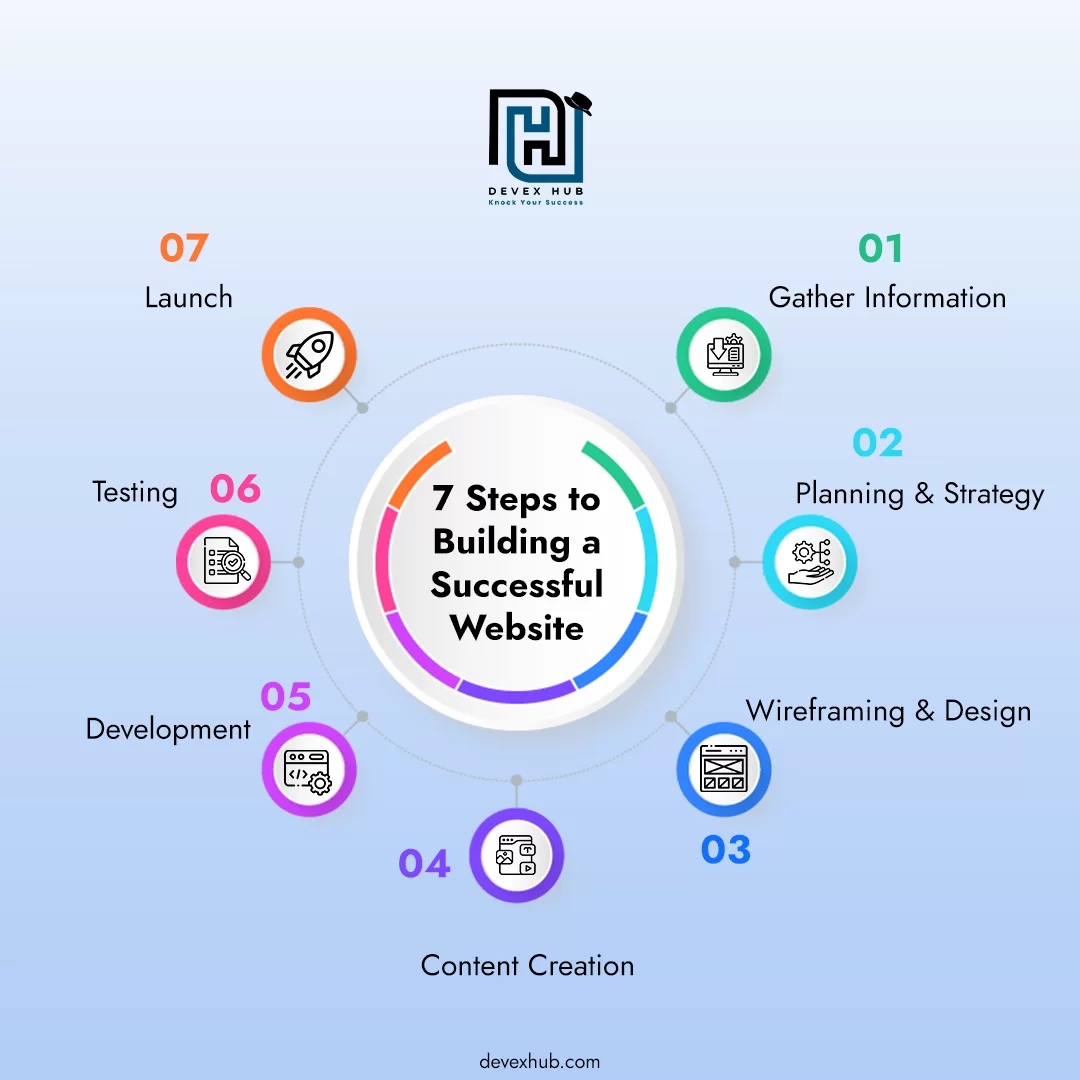Website Development Process: 7 Steps to Building a Successful Website

With billions of websites available on the internet, it has never been easier to have an international online presence. A website is highly essential for businesses as it is accessible to anyone, anywhere, anytime. So if you are looking to build a website, contact the best web development company in Mohali.
Coming to the web development process, no matter what type of website you are building, whether it is an e-commerce site, a social media page, or even your website, the development process always tends to follow the same path. However, if you start from scratch and do not have a plan, you might easily get lost in the details and overlook an essential aspect of your website—or end up spending much more time and money than you had planned.
By following these seven steps to building your website, you’ll be able to stay on track and produce a successful product that meets all of your objectives.
7 Steps of Web Development:
Before designing a website’s look and feel, there are many things to consider. The website development lifecycle consists of the following seven steps.
Gather Information:The process begins with the clarification of the needs and requirements of a website. Since custom website development requires a lot of time, so it is always recommended to first lay down the website requirements. A written document on the website requirements backed by analysis and research would lead you on a roadmap toward successful web development.
Some information that needs to be gathered at this stage is;
- Target Audience
- Website development Tools
- Budget
- Time-estimates
- Strategy
- Business Goals
- Website Niche
Planning & Strategy:Use the information you gather in the first phase of your web design and development process to prepare a detailed website plan. At this stage, it is crucial to prepare a sitemap, and user journeys. The sitemap defines the website navigation, key landing pages, and how they relate to one another, forming a seamless user journey.
Apart from this, the other things that need planning and strategy formation are to identify the following;
- Functionality and Marketing Requirements
- Integration Requirements
- CMS Requirements
- SEO Opportunities
- Conversion Funnels
Wireframing & Design: After creating a proper strategy and planning for the website development, the next step towards designing is to make a responsive and mobile-friendly website. To create a unique web design, we begin with;
- Creating Wireframes – Wireframing is a way to design a website service at the structural level. A wireframe is commonly used to lay out content and functionality on a page that considers user needs and user journeys. Wireframes are used early in the development process to establish the basic structure of a page before visual design and content are added.
- User Interface (UI) Design – The user interface is the process in which designers build an interface in computerized devices that primarily focuses on the looks and style of a website. This ensures that the interface has elements that are easy to access, understand, and use to facilitate those actions.
Content Creation: Creating content is a part of the web development phase. You must create content for all the pages because it is a very time-consuming process, and immensely challenging too. Therefore, before beginning content creation, a proper content management strategy is required. It will only help reduce any delays and keep the project planning on time.
Development: After meticulous planning and strategy of creating a website, finally, you reach the development phase, where you create a website.
To do that, firstly, you need to consider the document, where you mentioned the technologies you would need to create the website. The development of any website is divided into two parts;
- Front-end Development: The front-end web developer would work on the development of the client side of the website. This means the approved designs are turned into a live product. And the front side, the side that clients and visitors would be able to see, is developed by front-side developers using the programming languages; HTML, JavaScript, and CSS.
- Back-end Development: The back-end developers are engaged in a website’s data storage, security, and server-side functions that a user cannot see. Back-end development includes building and maintaining the back end of a website or web application. The programming languages include C++, Python, PHP, and Ruby on Rails.
Testing: This stage is the most crucial stage where the website performance test is conducted to check whether all the aspects of a website are working properly. In this step, comprehensive auditing of the product developed in the previous stages is carried out. Further, the testing teams ensure that the site meets the standards of an efficient and fully functioning website. At this stage, thorough checking of all pages, and links are done along with the site loading speed and responsiveness. Because, errors may be the result of small coding mistakes, and while it is often a pain to find and fix them, it is better to do it before launching a website than present a broken site to the public.
Launch:
Now comes the time, when you would share your months of efforts to build a website with the audience. At this stage, your website is ready to go live and is made available to the public. Once QA has been completed, a launch strategy will be prepared. This strategy will define the date and time when the website should be made available to the target audience. Finally, after you launch the website successfully, the development teams need to keep an eye on the site for weeks or months. This is to ensure that website is matching the expectations of the users to compete in the market.
Key Takeaway
To conclude, to build and maintain a successful website, it is crucial to follow certain steps in the right order. There are many different ways of doing this. But the seven-step website development process has proven effective in keeping costs down while delivering the best possible user experience and results to our clients. If you want to develop your website using this process, contact the best software development company in Mohali!


.png)

.png)

Comments
Post a Comment